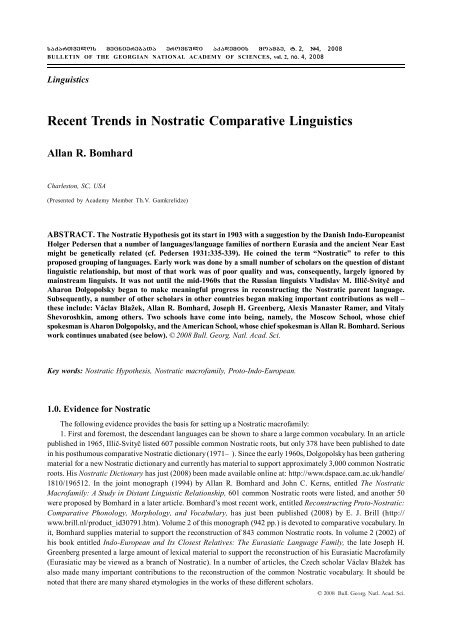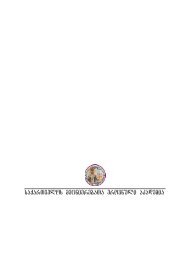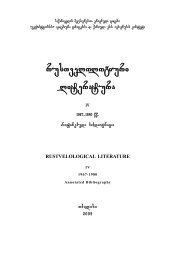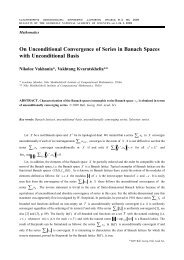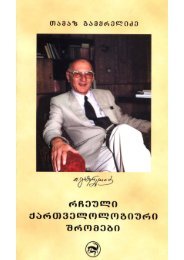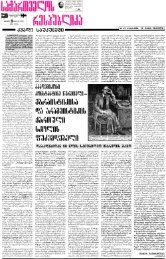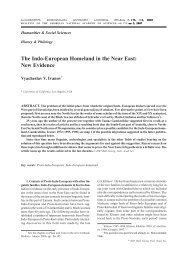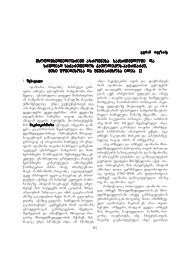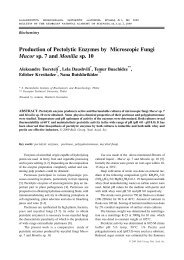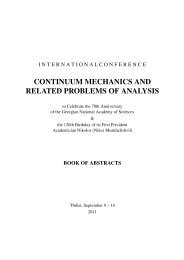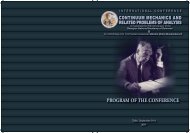Recent Trends in Nostratic Comparative Linguistics - The Georgian ...
Recent Trends in Nostratic Comparative Linguistics - The Georgian ...
Recent Trends in Nostratic Comparative Linguistics - The Georgian ...
You also want an ePaper? Increase the reach of your titles
YUMPU automatically turns print PDFs into web optimized ePapers that Google loves.
saqarTvelos mecnierebaTa erovnuli akademiis moambe, t. 2, #4, 2008<br />
BULLETIN OF THE GEORGIAN NATIONAL ACADEMY OF SCIENCES, vol. 2, no. 4, 2008<br />
L<strong>in</strong>guistics<br />
<strong>Recent</strong> <strong>Trends</strong> <strong>in</strong> <strong>Nostratic</strong> <strong>Comparative</strong> L<strong>in</strong>guistics<br />
Allan R. Bomhard<br />
Charleston, SC, USA<br />
(Presented by Academy Member Th.V. Gamkrelidze)<br />
ABSTRACT. <strong>The</strong> <strong>Nostratic</strong> Hypothesis got its start <strong>in</strong> 1903 with a suggestion by the Danish Indo-Europeanist<br />
Holger Pedersen that a number of languages/language families of northern Eurasia and the ancient Near East<br />
might be genetically related (cf. Pedersen 1931:335-339). He co<strong>in</strong>ed the term “<strong>Nostratic</strong>” to refer to this<br />
proposed group<strong>in</strong>g of languages. Early work was done by a small number of scholars on the question of distant<br />
l<strong>in</strong>guistic relationship, but most of that work was of poor quality and was, consequently, largely ignored by<br />
ma<strong>in</strong>stream l<strong>in</strong>guists. It was not until the mid-1960s that the Russian l<strong>in</strong>guists Vladislav M. Illič-Svityč and<br />
Aharon Dolgopolsky began to make mean<strong>in</strong>gful progress <strong>in</strong> reconstruct<strong>in</strong>g the <strong>Nostratic</strong> parent language.<br />
Subsequently, a number of other scholars <strong>in</strong> other countries began mak<strong>in</strong>g important contributions as well –<br />
these <strong>in</strong>clude: Václav Blažek, Allan R. Bomhard, Joseph H. Greenberg, Alexis Manaster Ramer, and Vitaly<br />
Shevoroshk<strong>in</strong>, among others. Two schools have come <strong>in</strong>to be<strong>in</strong>g, namely, the Moscow School, whose chief<br />
spokesman is Aharon Dolgopolsky, and the American School, whose chief spokesman is Allan R. Bomhard. Serious<br />
work cont<strong>in</strong>ues unabated (see below). © 2008 Bull. Georg. Natl. Acad. Sci.<br />
Key words: <strong>Nostratic</strong> Hypothesis, <strong>Nostratic</strong> macrofamily, Proto-Indo-European.<br />
1.0. Evidence for <strong>Nostratic</strong><br />
<strong>The</strong> follow<strong>in</strong>g evidence provides the basis for sett<strong>in</strong>g up a <strong>Nostratic</strong> macrofamily:<br />
1. First and foremost, the descendant languages can be shown to share a large common vocabulary. In an article<br />
published <strong>in</strong> 1965, Illič-Svityč listed 607 possible common <strong>Nostratic</strong> roots, but only 378 have been published to date<br />
<strong>in</strong> his posthumous comparative <strong>Nostratic</strong> dictionary (1971– ). S<strong>in</strong>ce the early 1960s, Dolgopolsky has been gather<strong>in</strong>g<br />
material for a new <strong>Nostratic</strong> dictionary and currently has material to support approximately 3,000 common <strong>Nostratic</strong><br />
roots. His <strong>Nostratic</strong> Dictionary has just (2008) been made available onl<strong>in</strong>e at: http://www.dspace.cam.ac.uk/handle/<br />
1810/196512. In the jo<strong>in</strong>t monograph (1994) by Allan R. Bomhard and John C. Kerns, entitled <strong>The</strong> <strong>Nostratic</strong><br />
Macrofamily: A Study <strong>in</strong> Distant L<strong>in</strong>guistic Relationship, 601 common <strong>Nostratic</strong> roots were listed, and another 50<br />
were proposed by Bomhard <strong>in</strong> a later article. Bomhard’s most recent work, entitled Reconstruct<strong>in</strong>g Proto-<strong>Nostratic</strong>:<br />
<strong>Comparative</strong> Phonology, Morphology, and Vocabulary, has just been published (2008) by E. J. Brill (http://<br />
www.brill.nl/product_id30791.htm). Volume 2 of this monograph (942 pp.) is devoted to comparative vocabulary. In<br />
it, Bomhard supplies material to support the reconstruction of 843 common <strong>Nostratic</strong> roots. In volume 2 (2002) of<br />
his book entitled Indo-European and Its Closest Relatives: <strong>The</strong> Eurasiatic Language Family, the late Joseph H.<br />
Greenberg presented a large amount of lexical material to support the reconstruction of his Eurasiatic Macrofamily<br />
(Eurasiatic may be viewed as a branch of <strong>Nostratic</strong>). In a number of articles, the Czech scholar Václav Blažek has<br />
also made many important contributions to the reconstruction of the common <strong>Nostratic</strong> vocabulary. It should be<br />
noted that there are many shared etymologies <strong>in</strong> the works of these different scholars.<br />
© 2008 Bull. Georg. Natl. Acad. Sci.
<strong>Recent</strong> <strong>Trends</strong> <strong>in</strong> <strong>Nostratic</strong> <strong>Comparative</strong> L<strong>in</strong>guistics 149<br />
2. As is to be expected, the various branches of <strong>Nostratic</strong> <strong>in</strong>vestigated to date exhibit regular sound correspondences<br />
(see the Appendix at the end of this paper for details), though, it should be mentioned, there are differences <strong>in</strong><br />
<strong>in</strong>terpretation between Illič-Svityč and Dolgopolsky on the one hand and Bomhard on the other (see below [§10.0]).<br />
3. F<strong>in</strong>ally, a substantial number of common grammatical formants have now been recovered – many of these are<br />
listed <strong>in</strong> Illič-Svityč’s comparative <strong>Nostratic</strong> dictionary (1971– ); see also Dybo (2004), the chapter on <strong>Nostratic</strong><br />
morphology by John C. Kerns <strong>in</strong> Bomhard–Kerns (1994:141–190), volume 1 of Greenberg’s Indo-European and Its<br />
Closest Relatives: <strong>The</strong> Eurasiatic Language Family (Greenberg 2000), and Chapters 16 and 17 of Bomhard’s new<br />
book Reconstruct<strong>in</strong>g Proto-<strong>Nostratic</strong> (Bomhard 2008.I:273–415).<br />
Notable among the lexical items uncovered by Illič-Svityč, Dolgopolsky, Greenberg, and Bomhard is a solid core of<br />
common pronom<strong>in</strong>al stems. <strong>The</strong>se pronom<strong>in</strong>al stems have particular importance, s<strong>in</strong>ce, as forcefully demonstrated by<br />
John C. Kerns (1985:9–50), pronouns, be<strong>in</strong>g among the most stable elements of a language, are a particularly strong<br />
<strong>in</strong>dicator of genetic relationship (Ruhlen 1994:92–93 makes the same po<strong>in</strong>t, as did Björn Coll<strong>in</strong>der before him).<br />
<strong>The</strong> conclusion seems <strong>in</strong>escapable that the consistent, regular phonological correspondences that can be shown<br />
to exist among the <strong>Nostratic</strong> daughter languages as well as the agreements <strong>in</strong> vocabulary and grammatical formants<br />
that have been uncovered to date cannot be expla<strong>in</strong>ed as due to l<strong>in</strong>guistic borrow<strong>in</strong>g or mere chance but can only be<br />
accounted for <strong>in</strong> terms of common orig<strong>in</strong>, that is, genetic relationship. To assume any other possibility would be<br />
tantamount to deny<strong>in</strong>g the efficacy of the <strong>Comparative</strong> Method. This does not mean that all problems have been<br />
solved. On the contrary, there rema<strong>in</strong> many issues to be <strong>in</strong>vestigated and many details to be worked out, but the future<br />
looks extremely excit<strong>in</strong>g and extremely promis<strong>in</strong>g.<br />
2.0. <strong>Nostratic</strong> Homeland<br />
Analysis of the available evidence has enabled us to determ<strong>in</strong>e the most likely homeland of the <strong>Nostratic</strong> parent<br />
language, to establish a time-frame dur<strong>in</strong>g which Proto-<strong>Nostratic</strong> might have been spoken, to date the dis<strong>in</strong>tegration<br />
of Proto-<strong>Nostratic</strong>, and to trace the early dispersal of the daughter languages. <strong>The</strong> follow<strong>in</strong>g scenario emerges: <strong>The</strong><br />
unified <strong>Nostratic</strong> parent language may be dated to between 15,000 to 12,000 BCE, that is, at the end of the last Ice<br />
Age – it was most likely located <strong>in</strong> the Fertile Crescent just south of the Caucasus Mounta<strong>in</strong>s. Beg<strong>in</strong>n<strong>in</strong>g around<br />
12,000 BCE, <strong>Nostratic</strong> began to expand, and, by 10,000 BCE, several dist<strong>in</strong>ct dialect groups had appeared. <strong>The</strong> first<br />
to split off from the ma<strong>in</strong> speech community was Afrasian. One dialect group spread from the Fertile Crescent to the<br />
northeast, eventually reach<strong>in</strong>g Central Asia sometime before 9,000 BCE – this was Eurasiatic. Another dialect group<br />
spread eastward <strong>in</strong>to western and central Iran, where it developed <strong>in</strong>to Elamo-Dravidian at about 8,000 BCE. If<br />
Johanna Nichols is correct <strong>in</strong> see<strong>in</strong>g Pre-Proto-Kartvelian as hav<strong>in</strong>g migrated from Central Asia westward below the<br />
Caspian Sea to the Caucasus, this would seem to imply that Pre-Proto-Kartvelian had first migrated northeastward<br />
from the Fertile Crescent along with or as part of Pre-Proto-Eurasiatic, that it stopped somewhere along the way, and<br />
that it then returned to the Middle East. For details, cf. Dolgopolsky 1998 and Bomhard 2008.1:221–252.<br />
<strong>The</strong> follow<strong>in</strong>g map shows the approximate location of the <strong>Nostratic</strong> homeland around 15,000 BCE:<br />
Bull. Georg. Natl. Acad. Sci., vol. 2, no. 4, 2008
150 Allan R. Bomhard<br />
At this stage of research, we can confidently say that the follow<strong>in</strong>g languages/language families are to be <strong>in</strong>cluded<br />
<strong>in</strong> the <strong>Nostratic</strong> macrofamily: Afrasian (also called Afroasiatic, Hamito-Semitic, Semito-Hamitic), Elamo-Dravidian,<br />
Kartvelian, and Eurasiatic. Eurasiatic, <strong>in</strong> turn, <strong>in</strong>cludes the follow<strong>in</strong>g: Tyrrhenian (Etruscan, Raetic, and Lemnian), Indo-<br />
European, Uralic-Yukaghir, Altaic (Mongolian, Turkic, and Tungus), Chukchi-Kamchatkan, Gilyak (also called Nivkh),<br />
and Eskimo-Aleut. Other languages may belong as well, such as, for example, Korean and Japonic (Japanese-Ryukyuan).<br />
But much work needs to be done before these two groups can be conv<strong>in</strong>c<strong>in</strong>gly shown to be related to Altaic (itself quite<br />
controversial), as is often assumed, let alone <strong>Nostratic</strong>.<br />
3.0. A Sketch of Proto-<strong>Nostratic</strong> Phonology<br />
Proto-<strong>Nostratic</strong> had a rich system of stops and affricates. Each stop and affricate series was characterized by the<br />
three-way contrast (1) voiceless (aspirated), (2) voiced, and (3) glottalized. <strong>The</strong> aspiration of series (1) was phonemically<br />
non-dist<strong>in</strong>ctive.<br />
<strong>The</strong> Proto-<strong>Nostratic</strong> phonological system may tentatively be reconstructed as follows (cf. Bomhard 2008.1:213–<br />
220; see Dolgopolsky 1998:101 for a slightly different reconstruction):<br />
3.1. Remarks on the Vowels<br />
<strong>The</strong> follow<strong>in</strong>g vowels may be reconstructed for Proto-<strong>Nostratic</strong>: *a, *e, *i, *o, and *u. At least some of these<br />
vowels must have been subject to considerable subphonemic variation <strong>in</strong> the <strong>Nostratic</strong> parent language. <strong>The</strong> high<br />
front and back vowels *i and *u, <strong>in</strong> particular, may be assumed to have had lowered variants (<strong>in</strong>dicated <strong>in</strong> the Proto-<br />
<strong>Nostratic</strong> reconstructions as *e and *o respectively), while the central low vowel *a may be assumed to have had<br />
higher variants (<strong>in</strong>dicated <strong>in</strong> the Proto-<strong>Nostratic</strong> reconstructions as *@). To complicate matters, *e and *o must also<br />
have existed as <strong>in</strong>dependent vocalic elements. It was the reanalysis, phonemicization, and exploitation of this<br />
subphonemic variation that gave rise to the ablaut and vowel harmony pattern<strong>in</strong>g found <strong>in</strong> the majority of the<br />
Bull. Georg. Natl. Acad. Sci., vol. 2, no. 4, 2008
<strong>Recent</strong> <strong>Trends</strong> <strong>in</strong> <strong>Nostratic</strong> <strong>Comparative</strong> L<strong>in</strong>guistics 151<br />
<strong>Nostratic</strong> daughter languages. It may be noted here that, accord<strong>in</strong>g to Greenberg (1990), traces of an earlier system of<br />
vowel harmony can be discerned <strong>in</strong> Proto-Indo-European.<br />
It is unclear whether phonemic long vowels existed <strong>in</strong> Proto-<strong>Nostratic</strong> as well, though the evidence seems to<br />
<strong>in</strong>dicate that they did not, except <strong>in</strong> nursery words.<br />
F<strong>in</strong>ally, it may be noted that, while any vowel (*a, *e, *i, *o, *u) could appear <strong>in</strong> <strong>in</strong>itial syllables, only *a, *i, *u<br />
could appear <strong>in</strong> non-<strong>in</strong>itial syllables. This is identical to the pattern<strong>in</strong>g found <strong>in</strong> Dravidian.<br />
4.0. Root Structure Pattern<strong>in</strong>g <strong>in</strong> Proto-<strong>Nostratic</strong><br />
Comparison of the various <strong>Nostratic</strong> daughter languages makes it possible to determ<strong>in</strong>e the rules govern<strong>in</strong>g the<br />
structural pattern<strong>in</strong>g of roots and stems <strong>in</strong> Proto-<strong>Nostratic</strong>. Most likely, the earliest pattern<strong>in</strong>g was as follows (cf.<br />
Bomhard 2008.1:215–216 and 1:391–394):<br />
1. <strong>The</strong>re were no <strong>in</strong>itial vowels <strong>in</strong> Proto-<strong>Nostratic</strong>. <strong>The</strong>refore, every root began with a consonant.<br />
2. Orig<strong>in</strong>ally, there were no <strong>in</strong>itial consonant clusters either. Consequently, every root began with one and only<br />
one consonant. Medial clusters were permitted, however.<br />
3. Two basic root types existed: (A) *CV and (B) *CVC, where C = any non-syllabic, and V =any vowel. Permissible<br />
root forms co<strong>in</strong>cided exactly with these two syllable types.<br />
4. A stem could either be identical with a root or it could consist of a root plus a s<strong>in</strong>gle derivational morpheme<br />
added as a suffix to the root: *CVC+CV-. Any consonant could serve as a suffix.<br />
5. A stem could thus assume any one of the follow<strong>in</strong>g shapes: (A) *CV-, (B) *CVC-, (C) *CVC+CV-, or (D)<br />
*CVC-CVC-. As <strong>in</strong> Proto-Altaic, the undifferentiated stems were real words <strong>in</strong> themselves and could be used without<br />
additional suffixes or grammatical end<strong>in</strong>gs. However, when so used, a vowel had to be added to the stem (unless the<br />
stem already ended <strong>in</strong> a vowel or <strong>in</strong> a semivowel, nasal, or liquid), thus: (A) *CV- > *CV (no change), (B) *CVC- ><br />
*CVC+V, (C) *CVC-CV- > (no change), or (D) *CVC-CVC- > *CVC-CVC+V. Follow<strong>in</strong>g Afrasian term<strong>in</strong>ology, this<br />
vowel may be called a “term<strong>in</strong>al vowel” (TV). Not only did term<strong>in</strong>al vowels exist <strong>in</strong> Proto-Afrasian, they were also<br />
found <strong>in</strong> Dravidian, where they are called “enunciative vowels”. As <strong>in</strong> Proto-Dravidian, the term<strong>in</strong>al vowel was only<br />
required <strong>in</strong> stems end<strong>in</strong>g <strong>in</strong> obstruents, which could not occur <strong>in</strong> f<strong>in</strong>al position.<br />
<strong>The</strong> orig<strong>in</strong>al root structure pattern<strong>in</strong>g was ma<strong>in</strong>ta<strong>in</strong>ed longer <strong>in</strong> Proto-Dravidian and Proto-Altaic than <strong>in</strong> the<br />
other branches, while the pattern<strong>in</strong>g found <strong>in</strong> Proto-Indo-European, Proto-Kartvelian, and Proto-Afrasian is based<br />
upon slightly later developments. <strong>The</strong> root structure constra<strong>in</strong>ts found <strong>in</strong> Proto-Indo-European were an <strong>in</strong>novation.<br />
In Proto-Uralic, the rule requir<strong>in</strong>g that all words end <strong>in</strong> a vowel was an <strong>in</strong>novation and arose from the <strong>in</strong>corporation<br />
of the so-called “term<strong>in</strong>al vowel” <strong>in</strong>to the stem. It should be mentioned that reduplication was a widespread phenomenon.<br />
On the basis of the evidence of Proto-Indo-European, Proto-Kartvelian, Proto-Afrasian, Proto-Dravidian, and<br />
Proto-Altaic, it may be assumed that there were three fundamental stem types: (A) verbal stems, (B) nom<strong>in</strong>al and<br />
adjectival stems, and (C) pronom<strong>in</strong>al and <strong>in</strong>decl<strong>in</strong>able stems. Some stems were exclusively nom<strong>in</strong>al. In the majority<br />
of cases, however, both verbal stems and nom<strong>in</strong>al stems could be built from the same root. In Proto-<strong>Nostratic</strong>, only<br />
pronom<strong>in</strong>al and <strong>in</strong>decl<strong>in</strong>able stems could end <strong>in</strong> a vowel. Verbal and nom<strong>in</strong>al stems, on the other hand, had to end <strong>in</strong><br />
a consonant, though, as noted above, when the undifferentiated stems were used as real words <strong>in</strong> themselves, a<br />
“term<strong>in</strong>al vowel” had to be added to the stem (but only when the stem ended <strong>in</strong> an obstruent). <strong>The</strong> term<strong>in</strong>al vowels<br />
were morphologically significant. Adjectives did not exist as an <strong>in</strong>dependent grammatical category <strong>in</strong> Proto-<strong>Nostratic</strong>.<br />
Dur<strong>in</strong>g the earliest period of Proto-<strong>Nostratic</strong>, roots could only have the forms: (A) *CV- and (B) *CVC-. Type<br />
(A) was restricted to pronom<strong>in</strong>al stems and <strong>in</strong>decl<strong>in</strong>ables, while type (B) characterized nom<strong>in</strong>al and verbal stems. A<br />
s<strong>in</strong>gle derivational formative could be placed after root type (B): *CVC + CV (derivational formative). Grammatical<br />
relationships were <strong>in</strong>dicated by plac<strong>in</strong>g particles either after the undifferentiated stem or after the stem plus a derivational<br />
formative: (A) *CVC + CV (particle [P]) or (B) *CVC + CV (derivational formative [DF]) + CV (particle<br />
[P]). In this scheme, a morphologically significant formative vowel (FV) had to be added either directly after the root<br />
if it ended <strong>in</strong> a consonant or between the root and any follow<strong>in</strong>g element, be it particle or derivational formative;<br />
thus, we get the follow<strong>in</strong>g patterns:<br />
(A) *CVC + V FV<br />
(plus particle: *CVC + V FV<br />
+ CV P<br />
)<br />
(B) *CVC + V FV<br />
+ CVDF (plus particle: *CVC + V FV<br />
+ CV DF<br />
+ CV P<br />
)<br />
(C) *CVC-CVC + V FV<br />
(plus particle: *CVC-CVC + V FV<br />
+ CV P<br />
)<br />
Bull. Georg. Natl. Acad. Sci., vol. 2, no. 4, 2008
152 Allan R. Bomhard<br />
Eventually, the vowel of the derivational formative after the stem plus formative vowel was lost <strong>in</strong> type (B) when a<br />
particle was added, as follows: *CVC + V FV<br />
+ C DF<br />
+ CV P<br />
. This is essentially the stage represented <strong>in</strong> Proto-Dravidian,<br />
though Proto-Dravidian has added long vowels to the equation as well as stems beg<strong>in</strong>n<strong>in</strong>g with a vowel (no doubt<br />
aris<strong>in</strong>g from the loss of <strong>in</strong>itial laryngeals). Next, the formative vowel was re<strong>in</strong>terpreted as part of the derivational<br />
formative <strong>in</strong> type (B): *CVC + VC + CV. This is the stage represented by Proto-Afrasian and is the basis for the root<br />
structure pattern<strong>in</strong>g found <strong>in</strong> Proto-Kartvelian and Proto-Indo-European as well. From an Afrasian perspective, there is<br />
no such th<strong>in</strong>g as “formative vowels” – they are only preserved <strong>in</strong> Dravidian and Elamite, though, <strong>in</strong> Elamite, their status<br />
is disputed.<br />
5.0. Proto-<strong>Nostratic</strong> Morphology<br />
<strong>The</strong> assumptions we make about the morphological and syntactical structure of a given proto-language profoundly<br />
affect the reconstructions that we propose. In what follows, we will be discuss<strong>in</strong>g Bomhard’s proposal<br />
(2008.1:387–391) that Proto-<strong>Nostratic</strong> may have been an active language. Now, active languages exhibit specific<br />
characteristics that set them apart from other morphological types. <strong>The</strong>refore, the reconstructions given below will<br />
conform with an active structure. However, it must be stressed that reconstructions should never be driven by theory<br />
alone. Rather, they must be fully consistent with the support<strong>in</strong>g data. Moreover, not only must our reconstructions be<br />
consistent with the support<strong>in</strong>g data, they must be consistent from a typological perspective as well, and they must be<br />
able to account for later developments <strong>in</strong> the descendant languages <strong>in</strong> as straightforward a manner as possible,<br />
without recourse to ad hoc rules. When reconstructions are driven by theory alone, the results can be disastrous.<br />
Several scholars have recently presented persuasive arguments <strong>in</strong> favor of reconstruct<strong>in</strong>g an early phase of<br />
Proto-Indo-European as an active language. Proto-Afrasian is also assumed to have been an active language. In<br />
active languages, subjects of both transitive and <strong>in</strong>transitive verbs, when they are agents semantically, are treated<br />
identically for grammatical purposes, while non-agent subjects and direct objects are treated differently. An “agent”<br />
may be def<strong>in</strong>ed as the entity responsible for a particular action or the entity perceived to be the cause of an action.<br />
Above, we mentioned that Proto-<strong>Nostratic</strong> had formative vowels. Now, it is curious that the formative vowel can<br />
take different shapes <strong>in</strong> Proto-Dravidian: *a, *i, or *u. This seems to <strong>in</strong>dicate that the different formative vowels<br />
must have had some sort of morphological significance at one po<strong>in</strong>t <strong>in</strong> time, even though this dist<strong>in</strong>ction has been<br />
lost <strong>in</strong> Dravidian. Not only must the formative vowels have had morphological significance, it is even probable that<br />
they had different significance depend<strong>in</strong>g upon whether a nom<strong>in</strong>al or verbal stem was <strong>in</strong>volved.<br />
For verbal stems, the formative vowels may have been aspect markers, as follows: *a marked imperfective, *i<br />
marked perfective, and *u marked subord<strong>in</strong>ate.<br />
For nom<strong>in</strong>al stems, the situation is a bit more complicated. <strong>The</strong> follow<strong>in</strong>g pattern<strong>in</strong>g may be reconstructed for<br />
the earliest period of development <strong>in</strong> Proto-<strong>Nostratic</strong>: *-i/*-u was used to mark the subject <strong>in</strong> active constructions,<br />
while *-a was used to mark the direct object <strong>in</strong> active constructions as well as the subject <strong>in</strong> stative constructions.<br />
*-a was also used to mark the so-called “status <strong>in</strong>determ<strong>in</strong>atus”.<br />
In later Proto-<strong>Nostratic</strong>, this pattern<strong>in</strong>g became disrupted, though it may have survived <strong>in</strong>to Proto-Afrasian. In later<br />
Proto-<strong>Nostratic</strong>, the relational markers *-ma and *-na came to be used to mark the direct object <strong>in</strong> active constructions<br />
as well as the subject <strong>in</strong> stative constructions. Eventually, these relational markers became the primary means of<br />
mark<strong>in</strong>g the direct object <strong>in</strong> active constructions or the subject <strong>in</strong> stative constructions, with the result that the older<br />
pattern<strong>in</strong>g became disrupted. Thus, <strong>in</strong> the latest stage of the <strong>Nostratic</strong> parent language, we f<strong>in</strong>d the follow<strong>in</strong>g pattern<strong>in</strong>g:<br />
1. *-i/*-u: used to mark the subject <strong>in</strong> active constructions:<br />
(A) *CVC + i/u<br />
(B) *CVC + i/u + CVDF<br />
(C) *CVC-CVC + i/u<br />
2. *-a ~ *-ma/*-na: used to mark the direct object <strong>in</strong> active constructions as well as the subject <strong>in</strong> stative<br />
constructions:<br />
(A) *CVC + a<br />
plus *-ma/*-na: *CVC + a + ma/na<br />
(B) *CVC + a + CV DF<br />
plus *-ma/*-na: *CVC + a + C(V) DF<br />
+ ma/na<br />
(C) *CVC-CVC + a<br />
plus *-ma/*-na: *CVC-CVC + a + ma/na<br />
Bull. Georg. Natl. Acad. Sci., vol. 2, no. 4, 2008
<strong>Recent</strong> <strong>Trends</strong> <strong>in</strong> <strong>Nostratic</strong> <strong>Comparative</strong> L<strong>in</strong>guistics 153<br />
*-ma/*-na was the first case form (bound relational marker) to develop <strong>in</strong> Proto-<strong>Nostratic</strong>. <strong>The</strong> second was the genitive<br />
(<strong>in</strong> the sense ‘belong<strong>in</strong>g to’) <strong>in</strong> *-nu. Indeed, these are the only two bound relational markers that can be confidently<br />
reconstructed for the latest period of Proto-<strong>Nostratic</strong>. F<strong>in</strong>ally, it seems likely that unextended *-a rema<strong>in</strong>ed as the<br />
<strong>in</strong>dicator of the status <strong>in</strong>determ<strong>in</strong>atus.<br />
Proto-<strong>Nostratic</strong> syntax was head-f<strong>in</strong>al, or left-branch<strong>in</strong>g, that is, dependents preceded their heads accord<strong>in</strong>g to<br />
the so-called “rectum-regens rule”. In other words, “adverbs” preceded verbs, “adjectives” preceded nouns, and<br />
auxiliaries followed the ma<strong>in</strong> verb, though it must be emphasized here that adjectives did not exist as an <strong>in</strong>dependent<br />
grammatical category <strong>in</strong> Proto-<strong>Nostratic</strong>. <strong>The</strong> unmarked syntactical order was Subject + Object + Verb (SOV).<br />
6.0. Pronom<strong>in</strong>al, Deictic, and Anaphoric Stems<br />
6.1. First Person Stems<br />
First person s<strong>in</strong>gular (active): *mi<br />
First person plural (<strong>in</strong>clusive, active): *ma<br />
First person (stative): *k h a<br />
First person (stative): *Ha<br />
First person s<strong>in</strong>gular: *na<br />
First person plural (exclusive, active): *na<br />
First person (postnom<strong>in</strong>al possessive/preverbal agentive): * iya<br />
6.2. Second Person Stems<br />
Second person (active): *t h i (~ * t h a)<br />
Second person: *si<br />
Second person: *ni<br />
6.3. Anaphoric and Deictic Stems<br />
Pronom<strong>in</strong>al base of unclear deictic function: *-gi/*-ge<br />
Deictic particle: (A) * a-/* {- (distant), (B) * i-/* e- (proximate), and (C) * u-/* o- (<strong>in</strong>termediate)<br />
Deictic particle: (A) *k h a-/*k h {- (proximate), (B) *k h u-/*k h o- (distant), and (C) *k h i-/*k h e- (<strong>in</strong>termediate)<br />
Deictic particle: (A) *t h a-/*t h {- (proximate), (B) *t h u-/*t h o- (distant), and (C) *t h i-/*t h e- (<strong>in</strong>termediate)<br />
Deictic particle: *ša-/*s{-<br />
Anaphoric pronoun stem: *si-/*se-<br />
Anaphoric pronoun stem: *na-, *ni-<br />
Deictic particle: *t yh a- ‘that over there, that yonder (not very far)’<br />
6.4. Interrogative, Relative, and Indef<strong>in</strong>ite Stems<br />
Relative: *k wh i-/*k wh e-; <strong>in</strong>terrogative: *k wh a-/*k wh {-<br />
Interrogative-relative stem: * ay-, * ya-<br />
Interrogative: *mi-; relative: *ma-<br />
Interrogative-relative: *na-<br />
Indef<strong>in</strong>ite: *ma-, *mi-, *mu-<br />
Indef<strong>in</strong>ite: *d y i-/*d y e- ‘this one, that one’<br />
7.0. Nom<strong>in</strong>al Morphology<br />
<strong>The</strong> overall structure of nom<strong>in</strong>als (nouns and adjectives) was as follows:<br />
Root + formative vowel (+ derivational suffix)<br />
(+ relational marker) (+ number marker)<br />
A stem could consist of the unextended root or the root extended by a s<strong>in</strong>gle derivational suffix (preceded, as<br />
<strong>in</strong>dicated above, by a formative vowel). As has already been noted, it is necessary to recognize two dist<strong>in</strong>ct periods of<br />
development <strong>in</strong> Proto-<strong>Nostratic</strong>. In the earliest phase of development, the relational markers listed below were free<br />
relational morphemes (postpositional particles). In later Proto-<strong>Nostratic</strong>, however, at least two of them were well on<br />
their way to becom<strong>in</strong>g bound relational morphemes (case suffixes).<br />
Bull. Georg. Natl. Acad. Sci., vol. 2, no. 4, 2008
154 Allan R. Bomhard<br />
As already noted, only the follow<strong>in</strong>g two bound relational markers (case suffixes) can be confidently reconstructed<br />
for the latest period of Proto-<strong>Nostratic</strong>: (A) direct object *-ma, *-na and (B) genitive *-nu. Other case relationships were<br />
expressed by postpositions (see below for a list), some of which developed <strong>in</strong>to bound case morphemes <strong>in</strong> the <strong>in</strong>dividual<br />
daughter languages. This is confirmed by Dravidian, where only the accusative (*-ay, *-Vn), dative (*-kk-/*-k-),<br />
and genitive (*-a, *-<strong>in</strong>) can be confidently reconstructed for the Dravidian parent language. Other case forms developed<br />
with<strong>in</strong> the Dravidian daughter languages. Likewise, only the follow<strong>in</strong>g two grammatical cases can be reconstructed<br />
for Proto-Uralic: (A) accusative *-m, which probably was used to mark the def<strong>in</strong>ite direct object of f<strong>in</strong>ite verbs,<br />
and (B) a subord<strong>in</strong>ate suffix *-n, which functioned as a genitive/nom<strong>in</strong>alizer with nouns and as an adverb formant with<br />
verbs. <strong>The</strong>re were also at least three local cases <strong>in</strong> Proto-Uralic: (A) locative *-nA, (B) separative *-tA ~ *-tI, and (C) and<br />
perhaps the latives *-k (and/or *-à) and *- t y (traditional *-ć) (and/or *-n y [traditional *-ń]). Denis S<strong>in</strong>or (1988:714–725)<br />
has devoted an important study to the question of common case markers between Uralic and Altaic. He, too, posits a<br />
Proto-Uralic accusative <strong>in</strong> *-m and a genitive <strong>in</strong> *-n. For the former, he notes that noth<strong>in</strong>g comparable can be posited for<br />
Proto-Turkic or Proto-Mongolian, but he does reconstruct a Proto-Tungus accusative *-m, which is <strong>in</strong> agreement with<br />
what is found <strong>in</strong> Uralic. <strong>The</strong> clearest parallels for the latter are to be found <strong>in</strong> the Proto-Mongolian genitive *-n and <strong>in</strong><br />
the Proto-Turkic genitive *-n. <strong>The</strong> genitive and accusative have converged <strong>in</strong> some Mongolian languages. This seems<br />
to <strong>in</strong>dicate that Proto-Mongolian may have preserved the *-n variant accusative form as opposed to the *-m variant<br />
found <strong>in</strong> Uralic and Tungus. S<strong>in</strong>or (1988:715–725) also discusses the Uralic and Altaic parallels between various local<br />
cases. F<strong>in</strong>ally, it is worth mention<strong>in</strong>g here that, with<strong>in</strong> Afrasian, Zaborski (1990:628) tentatively reconstructs the follow<strong>in</strong>g<br />
case morphemes for Proto-Omotic: (A) nom<strong>in</strong>ative *-i, (B) genitive-<strong>in</strong>strumental-directional *-kV, (C) dative *-s, (D)<br />
dative-comitative *-rV, (E) accusative *-a and *-nV, (F) <strong>in</strong>strumental-locative-directional-dative *-nV, and (G) ablative<br />
*-pV. Zaborski (1990:618) notes that some of these case forms may go back to earlier postpositions. Parallels with<br />
Cushitic show that at least some of these case forms go back to Proto-Afrasian. Diakonoff (1988:61) notes that the<br />
follow<strong>in</strong>g cases can be established for Proto-Afrasian with reasonable certa<strong>in</strong>ty: (A) *-Vš, *-šV locative-term<strong>in</strong>ative;<br />
(B) *-dV, *-Vd comitative, dative; (C) *-kV ablative and comparative; (D) *-Vm locative-adverbialis; (E) *-l directive;<br />
and (F) *-p (also *-f) ablative (<strong>in</strong> Omotic); conjunction, demonstrative pronoun <strong>in</strong> other languages. <strong>The</strong> ultimate<br />
<strong>Nostratic</strong> orig<strong>in</strong> of several of the case forms posited by Zaborski for Proto-Omotic and by Diakonoff for Proto-Afrasian<br />
is completely transparent.<br />
In Proto-<strong>Nostratic</strong>, adjectives did not exist as a separate grammatical category. <strong>The</strong>y were differentiated from nouns<br />
ma<strong>in</strong>ly by syntactical means – “adjectives” preceded the nouns they modified. Moreover, they did not agree with the<br />
head noun <strong>in</strong> number or gender.<br />
7.1. Relational Markers<br />
Direct object: *-ma<br />
Direct object: *-na<br />
Possessive: *-nu ‘belong<strong>in</strong>g to’<br />
Possessive: *-lV ‘belong<strong>in</strong>g to’<br />
Dative: *-na ‘to, for’<br />
Directive: *-k h a ‘direction to or towards, motion to or towards’<br />
Directive(-locative): *-ri ‘direction to or towards, motion to or towards (?)’<br />
Locative: *-ni ‘the place <strong>in</strong>, on, or at which someth<strong>in</strong>g exists or occurs’<br />
Locative, <strong>in</strong>strumental-comitative: *-ma ‘<strong>in</strong>, from, with’<br />
Locative: *-bi ‘<strong>in</strong> addition to, together with’<br />
Locative: *-i ‘near to, near by’ (?)<br />
Comitative-locative: *-da ‘together with’<br />
Oblique: *-t h a<br />
7.2. Dual and Plural Markers<br />
Dual: *k h i(-nV)<br />
Plural: *-t h a<br />
Plural: *-ri<br />
Plural: *-k h i<br />
Plural (Eurasiatic only): *-sV<br />
Bull. Georg. Natl. Acad. Sci., vol. 2, no. 4, 2008
<strong>Recent</strong> <strong>Trends</strong> <strong>in</strong> <strong>Nostratic</strong> <strong>Comparative</strong> L<strong>in</strong>guistics 155<br />
Plural/collective: *-la<br />
Plural: *-nV<br />
Note: plurality could also be expressed by reduplication of the root.<br />
7.3. Derivational Suffixes<br />
Nom<strong>in</strong>alizer: *-ri/*-re<br />
Nom<strong>in</strong>alizer: *-ma<br />
Nom<strong>in</strong>alizer: *-ya<br />
Nom<strong>in</strong>alizer: *-t h a<br />
Nom<strong>in</strong>alizer: *-na<br />
Nom<strong>in</strong>alizer: *-la<br />
Nom<strong>in</strong>alizer: *-k h a<br />
Nom<strong>in</strong>alizer: *-k’a<br />
8.0. Verbal Morphology<br />
In Proto-<strong>Nostratic</strong>, verbs fell <strong>in</strong>to two types of construction: (1) active and (2) stative. In active constructions,<br />
which usually <strong>in</strong>volved transitive verbs, the grammatical subject of the verb represented the agent perform<strong>in</strong>g the<br />
action, and the direct object represented the patient, or recipient, of the action. Stative constructions, on the other<br />
hand, expressed a state of affairs, rather than an event. Verbs expressed aspectual contrasts rather than temporal<br />
contrasts. Tense relates the time of the situation referred to to some other time, usually to the moment of speak<strong>in</strong>g,<br />
while aspect marks the duration or type of temporal activity denoted by the verb. Proto-<strong>Nostratic</strong> had two aspects: (A)<br />
perfective (past) and (B) imperfective (non-past). Proto-<strong>Nostratic</strong> also had, at the very least, the follow<strong>in</strong>g moods:<br />
(A) <strong>in</strong>dicative; (B) imperative; (C) conditional; (D) hortatory-precative; (E) <strong>in</strong>choative; and (F) prohibitive. <strong>The</strong>re<br />
was also a causative construction.<br />
<strong>The</strong> overall structure of verbs was as follows:<br />
Root + formative vowel (+ derivational suffix)<br />
(+ mood marker) (+ person marker) (+ number marker)<br />
A stem could consist of the unextended root or the root extended by a s<strong>in</strong>gle derivational suffix (preceded, as<br />
<strong>in</strong>dicated above, by a formative vowel). <strong>The</strong> position of the number marker seems to have been flexible – it could also<br />
be placed before the person marker. Gender was not marked. <strong>The</strong>re were no prefixes <strong>in</strong> Proto-<strong>Nostratic</strong>. We may note<br />
here that Krishnamurti (2003:279 and 312) posits the follow<strong>in</strong>g structure for verbs <strong>in</strong> Proto-Dravidian:<br />
Stem + tense-mood + (gender-)number-person marker<br />
Stative verbs were <strong>in</strong>different to number and, therefore, had no plural forms. <strong>The</strong>y also had a special set of<br />
person markers different from those of active verbs:<br />
Active person markers<br />
Stative person markers<br />
S<strong>in</strong>gular Plural<br />
1p. *mi *ma (<strong>in</strong>clusive) (+ plural marker) *k h a<br />
*na *na (exclusive) (+ plural marker) *Ha<br />
2p. *t h i *t h i (+ plural marker) *t h i<br />
*si<br />
*ni<br />
3p. *ša-/*šd- *ša-/*š@- (+ plural marker) *Ø<br />
*na-, *ni- *na-, *ni- (+ plural marker)<br />
Morphologically, verbs could be either f<strong>in</strong>ite or non-f<strong>in</strong>ite. F<strong>in</strong>ite forms could be marked for aspect, mood,<br />
person, and number, but not for gender or tense. Non-f<strong>in</strong>ite forms exhibited nom<strong>in</strong>al <strong>in</strong>flection. In unmarked word<br />
order, the verb occupied the end position of a clause.<br />
Bull. Georg. Natl. Acad. Sci., vol. 2, no. 4, 2008
156 Allan R. Bomhard<br />
8.1. Non-f<strong>in</strong>ite Verb Forms (Derivational Suffixes)<br />
<strong>The</strong> follow<strong>in</strong>g non-f<strong>in</strong>ite verb forms are widespread enough <strong>in</strong> the <strong>Nostratic</strong> daughter languages to guarantee their<br />
common orig<strong>in</strong>, and, consequently, they are listed separately here. However, at the Proto-<strong>Nostratic</strong> level, they were<br />
<strong>in</strong>dist<strong>in</strong>guishable from the nom<strong>in</strong>aliz<strong>in</strong>g suffixes listed above.<br />
Participle: *-na<br />
Participle: *-t h a<br />
Gerundive-participle: *-la<br />
8.2. F<strong>in</strong>ite Verb Forms: Mood Markers<br />
Imperative: *-k h a, *-k h i, *-k h i<br />
Conditional: *-ba<br />
Hortatory-precative: *-li<br />
Inchoative: *-na<br />
Note: the bare stem could also serve as imperative.<br />
8.3. F<strong>in</strong>ite Verb Forms: Others<br />
Causative: *-sV<br />
9.0. Prohibitive/Negative Particles and Indecl<strong>in</strong>ables<br />
<strong>The</strong> follow<strong>in</strong>g negative/prohibitive particles and <strong>in</strong>decl<strong>in</strong>ables can be reconstructed for Proto-<strong>Nostratic</strong>:<br />
Negative particles: *na, *ni, *nu<br />
Prohibitive particle: *ma( )<br />
Negative particle: * al- (~ * @l-)<br />
Negative particle: *li (~ *le) (?)<br />
Negative particle: * e<br />
Post-positional <strong>in</strong>tensify<strong>in</strong>g and conjo<strong>in</strong><strong>in</strong>g particle: *k wh a- (~ *k wh @-)<br />
Particle: *k wh ay- ‘when, as, though, also’<br />
Particle: *ħar y - ‘or; with, and; then, therefore’<br />
Particle: * <strong>in</strong>- (~ * en-), *(-)ni ‘<strong>in</strong>, <strong>in</strong>to, towards, besides, moreover’<br />
Sentence particle: *wa (~ *w@) ‘and, also, but; like, as’<br />
Coord<strong>in</strong>at<strong>in</strong>g conjunction: * aw-, * wa- (~ * w@-) ‘or’<br />
Note: <strong>The</strong> CVC- root structure pattern<strong>in</strong>g of some of these forms po<strong>in</strong>ts to their ultimate nom<strong>in</strong>al or verbal orig<strong>in</strong>.<br />
For example, the negative particle * al- (~ * @l-) must ultimately have been a negative verb stem mean<strong>in</strong>g ‘to be not soand-so’,<br />
as <strong>in</strong> its Dravidian derivatives, while * <strong>in</strong>- (~ * en-), *(-)ni was orig<strong>in</strong>ally a nom<strong>in</strong>al stem mean<strong>in</strong>g ‘place,<br />
location’.<br />
10.0. Remarks on <strong>Nostratic</strong> Sound Correspondences<br />
<strong>The</strong> <strong>Nostratic</strong> sound correspondences given <strong>in</strong> the tables <strong>in</strong> the Appendix to this article are based exclusively<br />
upon the work of Bomhard. <strong>The</strong>y differ <strong>in</strong> several significant respects from the sound correspondences proposed by<br />
the Moscow School, as represented <strong>in</strong> the work of Illič-Svityč and Dolgopolsky. Bomhard bases his views on three<br />
fundamental assumptions:<br />
1. <strong>The</strong> traditional reconstruction of the Proto-Indo-European consonant system is flawed and is to be re<strong>in</strong>terpreted<br />
along the l<strong>in</strong>es proposed, on the one hand, by Thomas V. Gamkrelidze and Vjačeslav V. Ivanov and,<br />
on the other hand, by Paul J. Hopper, as follows (the reconstruction of the Proto-Indo-European stop system<br />
posited by Lehmann is given for comparison):<br />
Lehmann<br />
Gamkrelidze – Ivanov<br />
Bull. Georg. Natl. Acad. Sci., vol. 2, no. 4, 2008
<strong>Recent</strong> <strong>Trends</strong> <strong>in</strong> <strong>Nostratic</strong> <strong>Comparative</strong> L<strong>in</strong>guistics 157<br />
2. <strong>The</strong> frequency distribution of Proto-<strong>Nostratic</strong> stops (and affricates) <strong>in</strong> the reconstruction proposed by Illič-<br />
Svityč and Dolgopolsky is <strong>in</strong> contradiction to typological predictions, and is, therefore, highly suspect (see<br />
below).<br />
3. Tak<strong>in</strong>g <strong>in</strong>to consideration (1) the radical re<strong>in</strong>terpretation of the Proto-Indo-European consonant system proposed<br />
by Gamkrelidze, Ivanov, and Hopper, as well as (2) the problems <strong>in</strong> the frequency distribution of stops<br />
(and affricates) <strong>in</strong> the reconstruction of the Proto-<strong>Nostratic</strong> phonological system proposed by Illič-Svityč and<br />
Dolgopolsky, a different set of <strong>Nostratic</strong> sound correspondences is warranted.<br />
Each of these assumptions must be evaluated <strong>in</strong>dependently. <strong>The</strong> reasons that each of these assumptions must be<br />
evaluated <strong>in</strong>dependently are as follows: Even if assumption 1 proves to be untenable, it does not <strong>in</strong>validate assumption<br />
2. Likewise, even if assumption 2 proves to be untenable, it does not <strong>in</strong>validate assumption 1. Assumption 3, on<br />
the other hand, is dependent upon assumption 2 but not assumption 1. That is to say, assumption 3 is not dependent<br />
upon any particular reconstruction of the Proto-Indo-European consonant system, though, it goes without say<strong>in</strong>g, if<br />
assumption 1 is valid, it re<strong>in</strong>forces the likelihood that the revised set of <strong>Nostratic</strong> sound correspondences that Bomhard<br />
has proposed is correct. Inasmuch as assumption 3 is dependent on assumption 2, however, if assumption 2 is<br />
<strong>in</strong>valid, then assumption 3 is unnecessary. Moreover, even if assumption 2 is valid and a different set of <strong>Nostratic</strong><br />
sound correspondences is warranted, it does not necessarily follow that the alternative correspondences that Bomhard<br />
has proposed are the only possible scenario, though other scenarios are considerably less likely.<br />
Let us now consider the basis for assumption 2: <strong>The</strong> mistake that Illič-Svityč and Dolgopolsky made was <strong>in</strong><br />
try<strong>in</strong>g to equate the glottalized stops of Proto-Kartvelian and Proto-Afrasian with the traditional pla<strong>in</strong> voiceless<br />
stops of Proto-Indo-European. <strong>The</strong>ir reconstruction would make the glottalized stops the least marked members <strong>in</strong><br />
the Proto-<strong>Nostratic</strong> labial series and the most marked <strong>in</strong> the velar series. Such a reconstruction is thus <strong>in</strong> contradiction<br />
to typological evidence, accord<strong>in</strong>g to which glottalized stops uniformly have the opposite frequency distribution<br />
(most marked <strong>in</strong> the labial series and least marked <strong>in</strong> the velar series). <strong>The</strong> reason that Illič-Svityč’s and Dolgopolsky’s<br />
reconstruction contradicts the typological evidence is as follows: Illič-Svityč and Dolgopolsky posit glottalics for<br />
Proto-<strong>Nostratic</strong> on the basis of a small number of seem<strong>in</strong>gly solid examples <strong>in</strong> which glottalics <strong>in</strong> Proto-Afrasian<br />
and/or Proto-Kartvelian appear to correspond to traditional pla<strong>in</strong> voiceless stops <strong>in</strong> Proto-Indo-European. On the<br />
basis of these examples, they assume that, whenever there is a voiceless stop <strong>in</strong> the Proto-Indo-European examples<br />
they cite, a glottalic is to be reconstructed for Proto-<strong>Nostratic</strong>, even when there are no glottalics <strong>in</strong> the correspond<strong>in</strong>g<br />
Kartvelian and Afrasian forms! This means that the Proto-<strong>Nostratic</strong> glottalics have the same frequency distribution<br />
as the Proto-Indo-European pla<strong>in</strong> voiceless stops. Clearly, this cannot be correct (Alexis Manaster Ramer 1997<br />
makes the same observation). <strong>The</strong> ma<strong>in</strong> consequence of the mistaken comparison of the glottalized stops of Proto-<br />
Kartvelian and Proto-Afrasian with the traditional pla<strong>in</strong> voiceless stops of Proto-Indo-European is that Illič-Svityč<br />
and Dolgopolsky are led to posit forms for Proto-<strong>Nostratic</strong> on the basis of theoretical considerations but for which<br />
there is absolutely no evidence <strong>in</strong> any of the <strong>Nostratic</strong> daughter languages.<br />
<strong>The</strong> question then arises: Do these criticisms completely <strong>in</strong>validate the cognate sets <strong>in</strong>volv<strong>in</strong>g glottalized stops<br />
(and affricates) proposed by Illič-Svityč and Dolgopolsky? Well, no, not exactly – it is not quite that simple. In many<br />
cases, the etymologies are correct, but the Proto-<strong>Nostratic</strong> reconstructions are wrong – here, a simple rewrit<strong>in</strong>g of the<br />
reconstructions is all that is required. Other examples adduced by Illič-Svityč and Dolgopolsky admit alternative<br />
explanations, while still others are questionable from a semantic po<strong>in</strong>t of view and should be abandoned. Once the<br />
questionable examples are removed, there is an extremely small number left over (no more than a handful) that<br />
appear to support their position. However, compared to the massive counter-evidence supplied by Bomhard (2008,<br />
volume 2), even these rema<strong>in</strong><strong>in</strong>g examples become suspect (they may be borrow<strong>in</strong>gs or simply false cognates).<br />
F<strong>in</strong>ally, there are even some examples where the comparison of glottalized stops <strong>in</strong> Proto-Kartvelian and Proto-<br />
Afrasian with pla<strong>in</strong> voiceless stops <strong>in</strong> Proto-Indo-European is correct. This occurs <strong>in</strong> the cases where two glottalics<br />
orig<strong>in</strong>ally appeared <strong>in</strong> a Proto-<strong>Nostratic</strong> root: *C’VC’-. Such roots are preserved without change <strong>in</strong> Proto-Kartvelian<br />
and Proto-Afrasian, while <strong>in</strong> Proto-Indo-European, they have been subject to a rule of regressive deglottalization:<br />
*C’VC’- > *CVC’-.<br />
Bull. Georg. Natl. Acad. Sci., vol. 2, no. 4, 2008
158 Allan R. Bomhard<br />
Appendix: <strong>Nostratic</strong> Sound Correspondences<br />
Bull. Georg. Natl. Acad. Sci., vol. 2, no. 4, 2008
<strong>Recent</strong> <strong>Trends</strong> <strong>in</strong> <strong>Nostratic</strong> <strong>Comparative</strong> L<strong>in</strong>guistics 159<br />
Bull. Georg. Natl. Acad. Sci., vol. 2, no. 4, 2008
160 Allan R. Bomhard<br />
Bull. Georg. Natl. Acad. Sci., vol. 2, no. 4, 2008
<strong>Recent</strong> <strong>Trends</strong> <strong>in</strong> <strong>Nostratic</strong> <strong>Comparative</strong> L<strong>in</strong>guistics 161<br />
Bull. Georg. Natl. Acad. Sci., vol. 2, no. 4, 2008
162 Allan R. Bomhard<br />
enaTmecniereba<br />
axali mimd<strong>in</strong>areobani nostratul SedarebiT<br />
enaTmecnierebaSi<br />
alan r. bomhardi<br />
Carlstoni, samxreT karol<strong>in</strong>a, aSS<br />
(warmodgenilia akademikos T. gamyreliZis mier)<br />
nostratuli hipoTeza saTaves iRebs 1903 wels, rodesac gamoCenili danieli enaTmecnieri<br />
holger pederseni ayenebs Tvalsazriss, rom CrdiloeT ev raziis mTeli rigi enebi SesaZlebelia<br />
monaTesaveni aRmoCndnen Zveli maxlobeli aRmosavleTis enebisa da enaTa ojaxebisa. h. pedersenma<br />
SemoiRo term<strong>in</strong>i “nostratuli enebi” am jgufis enaTa aRsaniSnavad.<br />
ukve adreve daiwyo kvleva am mimarTulebiT, e.i. enebs Soris “Soreuli naTesaobis” gamosavlenad,<br />
magram gamokvlevaTa umravlesoba iseTi donisa iyo, rom maT ar mouxdeniaT gavlena ZiriTad<br />
l<strong>in</strong>gvistur mimarTulebebze.<br />
mxolod gasuli saukunis 60-iani wlebidan iwyeba am mimarTulebiT seriozuli gamokvlevebis<br />
publikacia, rodesac rusma l<strong>in</strong>gvistebma vladislav iliC-svitiCma da aharon dolgopolskim<br />
SemogvTavazes “nostratuli” fuZe-enis rekonstruqciebi. mas Semdeg sxvadasxva qveynis l<strong>in</strong>gvistebi<br />
gamodian “nostratuli enis” rekonstruqciis w<strong>in</strong>adadebebiT...<br />
am mimarTulebiT amJamad Camoyalibebulia ori ZiriTadi skola: “moskovis skola”, romlis<br />
mTavari warmomadgenelia amJamad aharon dolgopolski, da amerikuli skola, romlis saTaveSia<br />
w<strong>in</strong>amdebare statiis avtori alan r. bomhardi. am mimarTulebiT Seuneleblad mimd<strong>in</strong>areobs<br />
mniSvnelovani kvleva-Zieba.<br />
BIBLIOGRAPHY<br />
Bomhard, Allan R.<br />
1984 Toward Proto-<strong>Nostratic</strong>: A New Approach to the Comparison of Proto-Indo-European and Proto-Afroasiatic.<br />
(Current Issues <strong>in</strong> L<strong>in</strong>guistic <strong>The</strong>ory, vol. 27). Amsterdam: John Benjam<strong>in</strong>s.<br />
1996 Indo-European and the <strong>Nostratic</strong> Hypothesis. Charleston, SC: SIGNUM Desktop Publish<strong>in</strong>g.<br />
1999 Review of Aaron Dolgopolsky, <strong>The</strong> <strong>Nostratic</strong> Macrofamily and L<strong>in</strong>guistic Palaeontology, <strong>in</strong>: Col<strong>in</strong> Renfrew and<br />
Daniel Nettle (eds.), <strong>Nostratic</strong>: Exam<strong>in</strong><strong>in</strong>g a L<strong>in</strong>guistic Macrofamily. Cambridge: <strong>The</strong> McDonald Institute for<br />
Archaeological Research, pp. 47-74.<br />
2008 Reconstruct<strong>in</strong>g Proto-<strong>Nostratic</strong>: <strong>Comparative</strong> Phonology, Morphology, and Vocabulary. 2 volumes, 1, 820 pp.<br />
Leiden and Boston, MA: E. J. Brill.<br />
Bomhard, Allan R., and John C. Kerns<br />
1994 <strong>The</strong> <strong>Nostratic</strong> Macrofamily: A Study <strong>in</strong> Distant L<strong>in</strong>guistic Relationship.Berl<strong>in</strong>, New York, and Amsterdam: Mouton<br />
de Gruyter.<br />
Diakonoff, Igor M.<br />
1988 Afrasian Languages. Moscow: Nauka.<br />
Bull. Georg. Natl. Acad. Sci., vol. 2, no. 4, 2008
<strong>Recent</strong> <strong>Trends</strong> <strong>in</strong> <strong>Nostratic</strong> <strong>Comparative</strong> L<strong>in</strong>guistics 163<br />
Dolgopolsky, Aharon<br />
1984 “On Personal Pronouns <strong>in</strong> the <strong>Nostratic</strong> Languages”, <strong>in</strong>: Otto Gschwantler, Károly Rédei, and Hermann Reichert<br />
(eds.), L<strong>in</strong>guistica et Philologica. Gedenkschrift für Björn Coll<strong>in</strong>der (1894-1983) [L<strong>in</strong>guistics and Philology. Memorial<br />
Volume for Björn Coll<strong>in</strong>der (1894-1983)]. Vienna: Wilhelm Braumüller, pp. 65-112.<br />
1994 “<strong>Nostratic</strong>”, <strong>in</strong>: R. E. Asher (ed.), <strong>The</strong> Encyclopedia of Language and L<strong>in</strong>guistics. Oxford: Pergamon Press, vol. 5,<br />
p. 2838.<br />
1998 <strong>The</strong> <strong>Nostratic</strong> Hypothesis and L<strong>in</strong>guistic Paleontology. Cambridge: <strong>The</strong> McDonald Institute for Archaeological<br />
Research.<br />
2008 <strong>Nostratic</strong> Dictionary. Published onl<strong>in</strong>e by <strong>The</strong> McDonald Institute at: http://www.dspace.cam.ac.uk/handle/1810/<br />
196512.<br />
Dybo, Vladimir<br />
2004 “On Illič-Svityč’s Study ‘Basic Features of the Proto-Language of the <strong>Nostratic</strong> Language Family’,” <strong>in</strong>: Irén Hegedűs and<br />
Paul Sidwell (eds.), <strong>Nostratic</strong> Centennial Conference: <strong>The</strong> Pécs Papers. Pécs: L<strong>in</strong>gua Franca Group, pp. 115-119.<br />
Gamkrelidze, Thomas V., and Vjačeslav V. Ivanov<br />
1995 Indo-European and the Indo-Europeans: A Reconstruction and Historical Typological Analysis of a Proto-Language<br />
and a Proto-Culture. 2 volumes, with a Preface by Roman Jakobson. English translation by Johanna Nichols. Berl<strong>in</strong>,<br />
New York, and Amsterdam: Mouton de Gruyter.<br />
Greenberg, Joseph H.<br />
1990 “<strong>The</strong> Prehistory of the Indo-European Vowel System <strong>in</strong> <strong>Comparative</strong> and Typological Perspective”, <strong>in</strong>: Vitaly<br />
Shevoroshk<strong>in</strong> (ed.), Proto-Languages and Proto-Cultures. Bochum: Brockmeyer, pp. 77-136.<br />
2000-2002 Indo-European and Its Closest Relatives: <strong>The</strong> Eurasiatic Language Family. 2 volumes. Stanford, CA: Stanford<br />
University Press.<br />
Illič-Svityč, Vladislav M.<br />
1965 “Материалы к сравнительному словарю ностратических языков (индоевропейский, алтайский, уральский,<br />
дравидский, картвельский, семитохамитский)” [Materials for a <strong>Comparative</strong> Dictionary of the <strong>Nostratic</strong> Languages<br />
(Indo-European, Altaic, Uralic, Dravidian, Kartvelian, Hamito-Semitic)], Этимология (Etimologija) 1965:321-373.<br />
1971- “Опыт сравнения ностратических языков (семитохамитский, картвельский, индоевропейский, уральский,<br />
дравидский, алтайский)” [An Attempt at a Comparison of the <strong>Nostratic</strong> Languages (Hamito-Semitic, Kartvelian,<br />
Indo-European, Uralic, Dravidian, Altaic)]. 3 volumes (1971, 1976, 1984). Moscow: Nauka.<br />
Kerns, John C.<br />
1967 Eurasiatic Pronouns and the Indo-Uralic Question. Fairborn, OH.<br />
1985 Indo-European Prehistory. Cambridge: Heffer and Sons.<br />
Krishnamurti, Bhadriraju<br />
2003 <strong>The</strong> Dravidian Languages. Cambridge: Cambridge University Press.<br />
Lehmann, W<strong>in</strong>fred P.<br />
1952 Proto-Indo-European Phonology. Aust<strong>in</strong>, TX: University of Texas Press.<br />
Manaster Ramer, Alexis<br />
1997 “<strong>Nostratic</strong> from a Typological Po<strong>in</strong>t of View”: Journal of Indo-European Studies 25.1/2:79-104.<br />
Pedersen, Holger<br />
1931 <strong>The</strong> Discovery of Language: L<strong>in</strong>guistic Science <strong>in</strong> the N<strong>in</strong>eteenth Century. English translation by John Webster<br />
Spargo. Midland book edition 1962. Bloom<strong>in</strong>gton, IN: Indiana University Press.<br />
Ruhlen, Merritt<br />
1994 <strong>The</strong> Orig<strong>in</strong> of Language: Trac<strong>in</strong>g the Evolution of the Mother Tongue. New York: John Wiley & Sons.<br />
S<strong>in</strong>or, Denis<br />
1988 “<strong>The</strong> Problem of the Ural-Altaic Relationship”, <strong>in</strong>: Denis S<strong>in</strong>or (ed.), <strong>The</strong> Uralic Languages: Description, History<br />
and Foreign Influences. Leiden: E.J. Brill, pp. 706-741.<br />
Starost<strong>in</strong>, Sergej A., Anna Dybo, and Oleg A. Mudrak<br />
2003 An Etymological Dictionary of Altaic Languages. 3 volumes. Leiden: E. J. Brill.<br />
Zaborski, Andrzej<br />
1990 “Prelim<strong>in</strong>ary Remarks on Case Morphemes <strong>in</strong> Omotic”, <strong>in</strong>: Richard J. Hayward (ed.), Omotic Language Studies.<br />
London: University of London. School of Oriental and African Studies, pp. 617-639.<br />
Bull. Georg. Natl. Acad. Sci., vol. 2, no. 4, 2008


